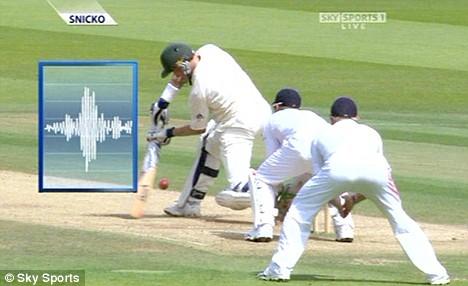How the snickometer works

One thing the cricket umpires at the Ashes will be doing this summer is listening. Did the ball clip the bat on the way through to being caught? Did the ball actually hit the pads meaning it isn’t caught out, but could be an LBW? This acute listening skill that cricketing umpires develop is mimicked in a piece of technology nicknamed snicko. The snickometer was invented in the 1990s by English computer scientist Alan Paskett. Although the umpires will not be using snicko for the Ashes this summer, broadcasters will be using it to review decisions. [1]


A microphone in the stumps picks up the sound and this is cleaned up to remove ambient noise by filtering. [2] What is displayed on the screen is what you might see on an oscilloscope or in a piece of music technology software. If the ball hits nothing, then the snicko graph shows nothing.
The two graphs here are some scientific measurements. [3] If the ball hits the bat (left graph), then the wood of the bat vibrates creating a clean sharp spike and a short sound is heard. If the pad or glove is hit, the impact is spread over a longer time, and with no wood to cleanly resonate the sound is usually intense (right graph). Where there is more than one sound, say if the bat also hits the ground, then synchronising the acoustic plots to slow-mo video replays can help reveal what the ball hit.
A simple bit of audio signal processing, it’s a shame it isn’t part of Umpire Decision Review System.
What is Real Time Snicko (RTS)?
With the Decision Review System (DRS) playing a major role in the Ashes, there are news reports about improving the technology. The old snickometer is slow because of a manual process needed to align video and audio; this is why it isn’t part of DRS. Real Time Snicko uses the same idea as Snicko but using a dedicated hardware system to automatically align picture and audio and so speed up the process. [4]
Notes
[1] http://tech.uk.msn.com/features/cricket-tech-the-technology-behind-the-ashes?page=4
[2] http://shashindrasri.blogspot.co.uk/2013/04/snickometer.html
[3] R. Rock, A. Als, P. Gibbs, C. Hunte, “The 5th Umpire: Cricket‟s Edge Detection System” Journal of Systemics, Cybernetics & Informatics;2013, Vol. 11 Issue 1, p4
[4] http://www.espncricinfo.com/ci/content/story/603632.html
Credits
Snicko photo: http://img.khelnama.com/sites/default/files/styles/large/public/snicko.jpg
Follow me
12 responses to “The science behind snicko”
What sound is made if the ball misses the bat by say a few thousandths of an inch, compressing the air between the two objects which then expands?
Could this explain a sound but no mark on hot spot?
I doubt it it would make enough sound to be audible. Thanks for the interesting thought.
Hi
You may well be right but has any research been done?
A metal ball passing close to a metal surface where these are connected electrically would prove what noise is created without physical contact
The air raid siren is an example of air just being “chopped” producing a series of expansions. I also remember a kids toy, a triangle of cardboard with a paper pocket as an insert. When moved quickly the insert would become external with a loud crack as the air was forced out of a pocket.
You can also hear a cricket ball and golf ball as it passes you at speed, the disturbance in the air is clearly audible
Any comments?
I can only think of whistling sound from a ball when it is very close to the ear, would the sound be loud enough to be picked up by the stump microphone (with all the other noise around)?
Hi
Thanks for the response
The reason I contacted you is that I am trying to take the guesswork out of it.
The way I envisage is the old tried and tested way-by experiment
A project for one of your students maybe?
Regards
Chris
The reason ‘Old Snicko’ isn’t in DRS is because, since I came up with the original design in 1998, several imitation versions. some legitimate some not, have been in use around the world. The ICC would have had to assess and validate them all. If you read my original patent, you will see that the alignment of sound and video is automatic for sounds within 3 and 10 feet of the stump microphone.
Does Snicko take into account the distance the ball or bat is from the mic? It seems that in order to be accurate, it would need to have varying sync depending on the distance the ball is from the mic.
Do have a graph that shows the relationship between the amplitude and the frequency of a cricket ball snick on the bat? Principally I want to know the frequency range of the highest amplitude.
Sorry, no
Reblogged this on #HarishTheBlogger and commented:
An excellent blog about Snicko tech . Comments are really thoughtful..
[…] http://trevorcox.me/the-science-behind-snicko […]
Hello;
Just wondering what the frame rate of the video used in snicko is and whether it is variable, and how this relates to the sample rate of the audio. Do these affect each other?
When a still from a video is shown, how does the audio relate to this still shot. The still shot is a single snapshot in time, whereas the audio is of a length of time…follow up question, what is this length of time?
Is it true that the smallest nick measurable will be related to the sample rate of the audio. So assuming sample rate is at 44khz, then smallest nic would be 0.022ms?
Many thanks, interested in getting into the details.